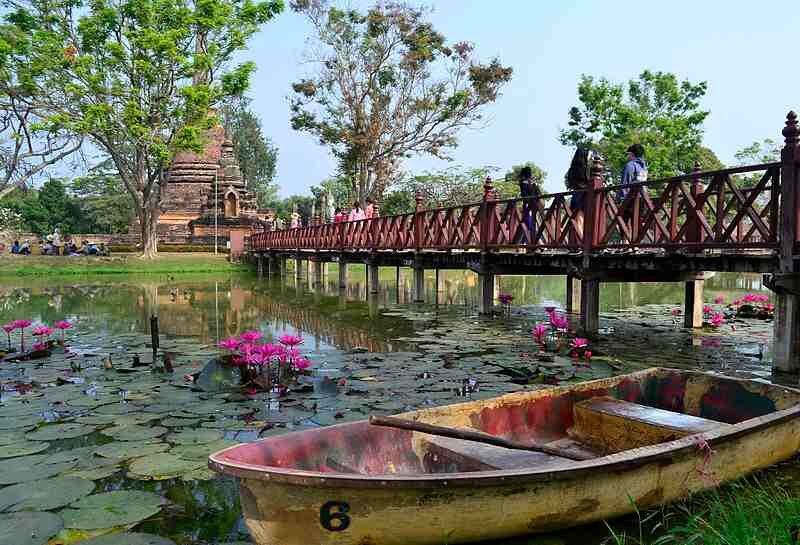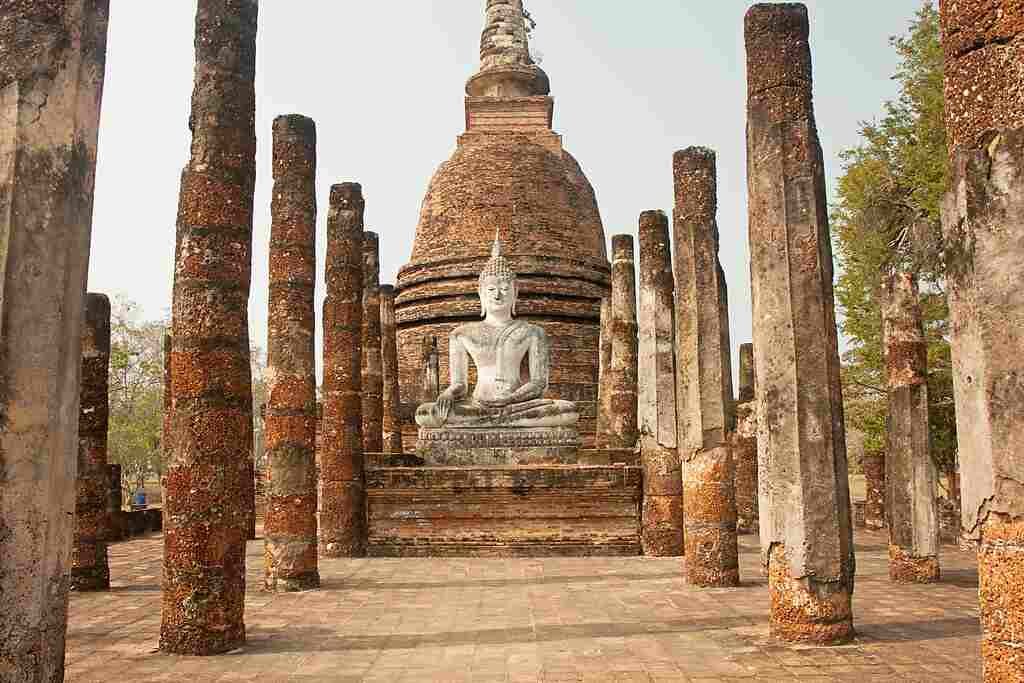The ancient city of Sukhothai is a remarkable cradle of Thai culture, filled with fascinating historical landmarks. Among them, Wat Sa Si stands out as a true gem nestled in the heart of the Sukhothai Historical Park.
Its serene beauty, exceptional architecture, and significant cultural legacy make it a must-visit destination for those looking to dive deep into Thailand’s glorious past.
In this article, we will take you on a journey to discover Wat Sa Si, providing a rich understanding of its historical importance, cultural relevance, and why it remains a favorite among both locals and international travelers alike.

Historical Events Associated with Wat Sa Si
Wat Sa Si, located in Sukhothai Historical Park, is steeped in history and significance. The temple was founded towards the end of the 14th century, around 1384, as indicated by inscriptions found in the area.
It was built to enshrine the ashes of King Li Thai, a notable ruler of the Sukhothai kingdom who reigned from 1368 to 1370. This connection to the royal lineage underscores the temple’s importance as a religious and cultural site during its time.
The name “Sa Si” translates to “Temple of the Sacred Pond,” aptly describing its picturesque location on a small island in the middle of Tra Phang Tra Kuan pond. This serene setting not only enhances the temple’s beauty but also reflects the Sukhothai era’s emphasis on harmony between architecture and nature.
The architectural style of Wat Sa Si reflects influences from Sinhalese Buddhism, which indicates cultural exchanges between Thailand and Sri Lanka.
The main chedi, a bell-shaped structure, exemplifies this style and serves as a focal point for visitors. The temple complex also includes an assembly hall (viharn) and an ordination hall (ubosot), which were integral to the monastic community’s activities.
In 1978, a significant event occurred when a road that ran through the temple site was demolished by the Thai Fine Arts Council to preserve Wat Sa Si and its surroundings.
This action demonstrated a commitment to protecting Thailand’s cultural heritage.

Architectural Marvels of Wat Sa Si
Wat Sa Si is distinguished by its stunning location on a small island in Tra Phang Tra Kuan pond, surrounded by blooming lotus flowers.
This idyllic setting enhances its beauty and provides a tranquil atmosphere for reflection and exploration. Visitors access the temple via a narrow wooden bridge that adds to its charm.
Here’s a detailed look at the architectural marvels that make Wat Sa Si a must-visit site in Thailand.
1. Main Chedi
The centerpiece of Wat Sa Si is its main chedi, which is a well-preserved bell-shaped structure designed in the Sinhalese style. This architectural choice highlights the influence of Sri Lankan Buddhism on the region. Key features include:
Bell Shape: The chedi’s bell shape symbolizes enlightenment and is characteristic of Sukhothai architecture.
Square Base: It is set on a square base, which adds stability and grandeur to the structure.
Historical Significance: According to inscriptions, this chedi was built to enshrine the ashes of King Li Thai, emphasizing its importance as a royal burial site.
2. Smaller Chedi
Adjacent to the main chedi is a smaller circular chedi, which also features significant architectural elements:
Four Niches: The smaller chedi has four large niches that once housed images of the Buddha, showcasing the temple’s dedication to Buddhist worship.
Walking Buddha Statue: In front of this chedi stands a graceful statue of a walking Buddha in the Vitarka mudra, symbolizing teaching and discussion.
3. Viharn (Assembly Hall)
The viharn, or assembly hall, is another critical component of Wat Sa Si:
Pillared Structure: Although only the base and rows of pillars remain today, it reflects the grandeur of ancient assembly halls where monks would gather for teachings and ceremonies.
Buddha Image: At the back of the viharn sits a large stuccoed stone image of the Buddha in the Bhumisparsha mudra, symbolizing the moment of enlightenment when Buddha called upon the Earth to witness his attainment of Nirvana.
4. Ubosot (Ordination Hall)
The ubosot, or ordination hall, is located on a separate small island connected by a bridge:
Significance: This area marks the sacred space for ordination ceremonies and is surrounded by sema stones that define its boundaries.
Architectural Features: The ubosot’s base and pillars remain intact, indicating its former grandeur and importance in monastic rituals.
In summary, Wat Sa Si stands as an architectural gem within Sukhothai Historical Park, embodying historical significance, artistic beauty, and spiritual reverence.
Its structures—particularly the main chedi, smaller chedi, viharn, and ubosot—reflect the rich cultural heritage of Thailand during the Sukhothai period.
♣♣ To learn more about Sukhothai and Sukhothai Historical Park, check out our beautiful article.⇒ Tremendous Sukhothai, Thailand: A Rich Historic Hub
♣♣You May Also Like: ⇓
- Attractive Wat Traphang Ngoen: The Jewel of Sukhothai
- Daring Wat Si Chum: The Surprising Temple of Sukhothai
- Fascinating Wat Saphan Hin: A Hilltop Haven in Sukhothai
- Colorful Wat Arun: Beautiful Temple of Dawn in Thailand
Festivals and Rituals
Wat Sa Si, like many temples in Thailand, is a focal point for various religious festivals and rituals. The Loy Krathong festival, celebrated annually in November, is particularly enchanting.
During this festival, locals and tourists alike release beautifully decorated krathongs (floating lanterns) into the pond, creating a mesmerizing spectacle of lights and reflections.
Why Visit Wat Sa Si?
Visiting Wat Sa Si provides a unique opportunity to immerse oneself in the history and spirituality of Thailand. Here are a few compelling reasons to add this temple to your itinerary:
1. Cultural Significance
Wat Sa Si is a key piece of the puzzle that makes up the rich tapestry of Sukhothai’s history. Exploring the temple allows visitors to gain a deeper understanding of the Sukhothai Kingdom’s influence on Thai culture and Buddhism.
2. Stunning Photography Opportunities
The combination of the ancient structures, the lotus pond, and the serene landscape makes Wat Sa Si an ideal location for photography. Whether you are a professional photographer or a casual visitor, you’ll find countless picturesque scenes to capture.
3. Peaceful Atmosphere
Unlike some of the more crowded tourist spots, Wat Sa Si offers a tranquil environment where visitors can reflect and appreciate the beauty of the surroundings. It’s a perfect place for meditation or simply enjoying nature.
4. Accessibility
Located within the Sukhothai Historical Park, Wat Sa Si is easily accessible by foot or bicycle. The park itself is a UNESCO World Heritage Site, making it a must-visit for anyone interested in history and culture.

Practical Information for Visitors
Getting There
Sukhothai is well-connected by bus and train from major cities like Bangkok and Chiang Mai. Once in Sukhothai, the historical park, including Wat Sa Si, can be explored on foot or by renting a bicycle.
Wat Sa Si is open year-round, with the best time to visit being early morning or late afternoon to avoid the heat and enjoy a more peaceful experience.
Entrance Fees
Access to the Sukhothai Historical Park, which includes Wat Sa Si, typically requires an entrance fee. Be sure to check the current rates before your visit.
Nearby Attractions
Sukhothai Historical Park is home to numerous other significant temples and monuments. Just a short walk from Wat Sa Si, you can explore:
Wat Mahathat: The largest and most important temple in the park, known for its impressive central chedi and numerous Buddha images.
Wat Si Chum: Famous for its massive seated Buddha image, partially visible through a narrow slit in the temple’s facade.
Wat Tra Phang Ngoen: Another beautiful temple located on an island, similar to Wat Sa Si, with a stunning central chedi and serene surroundings.
Conclusion
Wat Sa Si is more than just an architectural marvel; it is a serene sanctuary that encapsulates the essence of the Sukhothai Kingdom’s spiritual and cultural heritage.
The temple’s harmonious blend of Sukhothai and Singhalese styles, its tranquil setting amidst a lotus-filled pond, and its historical significance create a captivating narrative that resonates with both history enthusiasts and spiritual seekers alike.
As you wander through the serene pathways of Wat Sa Si, you are not merely observing ancient structures; you are stepping into a timeless realm where history, art, and spirituality converge.
The graceful Buddha images, the symmetrical layout, and the integration with nature all contribute to an atmosphere of peace and contemplation.
Visiting Wat Sa Si is a journey into the heart of Sukhothai’s golden age, offering a profound connection to the past and a moment of reflection in the present.
Whether you are drawn by its historical allure, its architectural beauty, or its spiritual ambiance, Wat Sa Si promises an unforgettable experience that will linger in your memory long after you leave its sacred grounds.
1 thought on “Beautiful Wat Sa Si: A Gem in Sukhothai Historical Park”